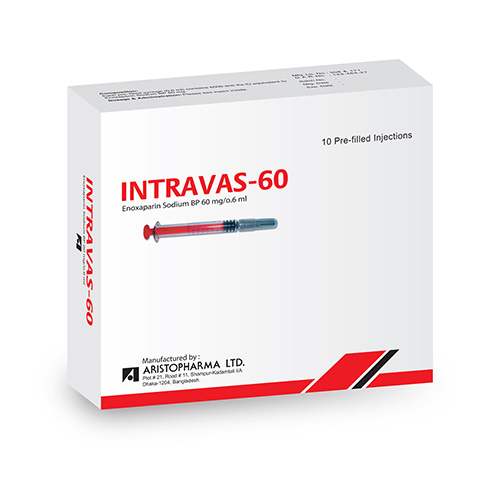
INTRAVAS 60 Injection
Therapeutic Class
Anticoagulants, Antiplatelets & Fibrinolytics (Thrombolytics)
Indications
Intravas is indicated for: Treatment of deep vein thrombosis, with or without pulmonary embolism. Treatment of unstable angina and non-Q-wave myocardial infarction, administered concurrently with aspirin. Prevention of thrombus formation in the extra-corporal circulation during haemodialysis. Prophylaxis of venous thromboembolic disease (prevention of blood clot formation in the veins), in particular those which may be associated with orthopedic or general, major colorectal or cancer surgery. Prophylaxis of venous thromboembolic disease in medical patients bedridden due to acute illness including acute heart failure, respiratory failure, severe infections & rheumatic diseases.
Chemical Composition
Enoxaparin Sodium BP 60 mg
Packaging
Each box contains 1 pre-filled syringe containing 6000 anti-Xa IU equivalent to Enoxaparin Sodium BP 60 mg (0.6 ml) in a blister pack
Dosage & Administration
Dosage: Prophylaxis of deep-vein thrombosis especially in surgical patients: by subcutaneous injection, moderate risk, 20 mg (2000 units) approx. 2 hours before surgery then 20 mg (2000 units) every 24 hours for 7-10 days; high risk (e.g. orthopaedic surgery), 40 mg (4000 units) 12 hours before surgery then 40 mg (4000 units) every 24 hours for 7 to10 days. Prophylaxis of deep-vein thrombosis in medical patients: by subcutaneous injection, 40 mg (4000 units) every 24 hours for at least 6 days and continued until patient ambulant (max. 14 days). Treatment of deep-vein thrombosis or pulmonary embolism: by subcutaneous injection, 1.5 mg/kg (150 units/kg) every 24 hours, usually for at least 5 days (and until adequate oral anticoagulation established). Treatment of acute ST-segment elevation myocardial infarction: adult under 75 years, by intravenous injection, 30 mg (3000 units) followed by subcutaneous injection, 1 mg/kg (100 units/kg), then by subcutaneous injection, 1 mg/kg every 12 hours for up to 8 days, max. 100 mg (10 000 units) for first two subcutaneous doses only; elderly over 75 years, by subcutaneous injection only, 750 micrograms/kg (75 units/kg) every 12 hours, max. 75 mg (7500 units) for first two doses only; patients undergoing percutaneous coronary intervention, additional dose, by intravenous injection, 300 micrograms/kg (30 units/kg) at time of procedure if last subcutaneous dose given more than 8 hours previously. Note: When administered in conjunction with a thrombolytic, enoxaparin should be given between 15 minutes before and 30 minutes after the start of thrombolytic therapy. Unstable angina and non-ST-segment-elevation myocardial infarction: by subcutaneous injection, 1 mg/kg (100 units/kg) every 12 hours usually for 2-8 days (minimum 2 days). Prevention of clotting in extracorporeal circuits: The recommended dose is 1 mg/kg. For patients with a high risk of haemorrhage the dose should be reduced to 0.5 mg/kg for double vascular access or 0.75 mg/kg for singular vascular access. During haemodialysis, Enoxaparin should be introduced into the arterial line of the circuit at the beginning of the dialysis session. The effect of this dose is usually sufficient for a 4-hour session however, if fibrin rings are found, such as after a longer than normal session, a further dose of 0.5 to 1 mg/kg may be given. Treatment of venous thromboembolism in pregnancy: by subcutaneous injection, early pregnancy body-weight under 50 kg, 40 mg (4000 units) twice daily; body-weight 50-70 kg, 60 mg (6000 units) twice daily; body-weight 70-90 kg, 80 mg (8000 units) twice daily; body-weight over 90 kg, 100 mg (10 000 units) twice daily.Intravas prefilled disposable syringe is ready for immediate use. Intravas contains no antimicrobial agent and should be used only once and then discarded. Intravas should be injected by deep subcutaneous route in prophylactic and curative treatment and by intravenous route during hemodialysis. DO NOT ADMINISTER BY THE INTRAMUSCULAR ROUTE. The air bubble from the syringe should not be expelled before the injection. The subcutaneous injection should preferably be made when the patient is lying down. Intravas is administered alternatively between the left & right anterolateral or posterolateral abdominal wall. The whole length of the needle should be introduced vertically into a skin fold gently held between the thumb and forefinger. The skin fold should not be released until the injection is complete.
Contraindications
Hypersensitivity to either Enoxaparin, heparin or other low molecular weight heparins; major clotting disorders like history of thrombocytopenia, active gastro-intestinal ulcer or organic lesion likely to bleed, recent haemorrhagic vascular cerebral stroke. Although rare, cutaneous or systemic allergic reactions may occur.
Side Effects
Haemorrhage (bleeding), thrombocytopenia, local reactions (pain, haematoma and mild local irritation) may follow the subcutaneous injection of Enoxaparin. There have been reports of neuraxial haematomas with the concurrent use of Enoxaparin Sodium and spinal/epidural anaesthesia or spinal puncture resulting in varying degrees of neurologic injuries
Drug Interaction
It is recommended that agents, which affect haemostasis should be discontinued prior to Enoxaparin Sodium therapy unless strictly indicated. These agents include medications such as: systemic salicylates, acetylsalicylic acid and NSAID's including ketorolac, dextran 40, ticlopidine and clopidogrel; systemic glucocorticoids; thrombolytics and anticoagulants; other anti platelet agents including Glycoprotein IIb/IIIa antagonists

